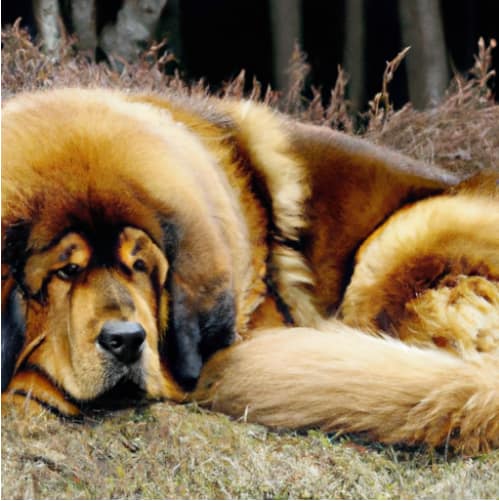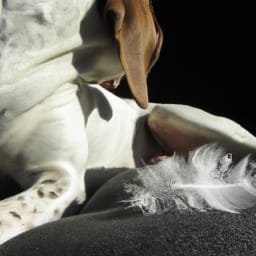Tibetan Mastiff Shedding: Why Do Tibetan Mastiffs Shed?
Do Tibetan Mastiffs Shed? If you’ve ever owned a Tibetan Mastiff or are considering getting one, you may have heard about their Tibetan Mastiff shedding habits. Tibetan Mastiffs are known for their luxurious and thick coats, but with that comes the inevitable shedding. In this article, we’ll explore the reasons behind why Tibetan Mastiffs shed and provide valuable insights into managing their shedding patterns. So if you’re ready to uncover the mysteries of this majestic breed’s shedding, keep reading!
Tibetan Mastiffs Shedding: Why Do Tibetan Mastiffs Shed?
Tibetan Mastiffs are majestic and beautiful creatures that captivate the hearts of dog lovers around the world. With their luxuriously thick coats and regal appearance, they are often referred to as the “lion dog” or “bear dog.” However, as stunning as their fur may be, Tibetan Mastiffs are known for their heavy shedding. In this article, we will explore the reasons behind Tibetan Mastiffs shedding, as well as tips and tricks to minimize shedding and maintain your dog’s beautiful coat.
Physical Characteristics of Tibetan Mastiffs
Before delving into shedding, it is important to understand the physical characteristics of Tibetan Mastiffs. These dogs have a dense double coat that consists of a soft undercoat and a longer, coarser outer layer. This combination of fur provides them with insulation against extreme temperatures, making them well-suited for their original purpose as livestock guardians in the harsh regions of Tibet.
Understanding Shedding in Dogs
Shedding is a natural process for all dogs, regardless of breed. It is a way for dogs to remove old or damaged hairs and make way for new growth. Shedding also helps regulate body temperature and keeps the skin healthy. However, the extent and frequency of shedding can vary between breeds.

Frequency and Amount of Shedding in Tibetan Mastiffs
Tibetan Mastiffs are known to be heavy shedders. They shed their dense coats all year round, but the shedding tends to increase during certain seasons. This shedding pattern can be attributed to various factors such as hormonal changes, environmental conditions, and overall health.
Seasonal Shedding in Tibetan Mastiffs
While Tibetan Mastiffs shed throughout the year, they often experience more intense shedding during seasonal transitions. In spring, they shed their thick winter coat to make way for a lighter coat suitable for the warmer months. Similarly, in the fall, they shed their summer coat to prepare for the colder temperatures ahead. This shedding is a natural and necessary process for the dog’s well-being.

Health Factors Affecting Shedding
The health of a Tibetan Mastiff plays a crucial role in their shedding patterns. Dogs that are not in optimal health may have imbalances in hormones, skin issues, or nutritional deficiencies, which can lead to excessive shedding. It is essential to ensure that your dog receives regular veterinary care, including check-ups and proper vaccinations, to minimize any underlying health issues that may contribute to shedding.
Nutrition and its Impact on Shedding
A well-balanced and nutritious diet is essential for a Tibetan Mastiff’s overall health, including their coat condition. Dogs deficient in key nutrients such as omega-3 fatty acids, biotin, and zinc may experience dull and brittle fur, leading to increased shedding. Ensure that your dog’s diet includes high-quality protein sources, essential fatty acids, and a variety of vitamins and minerals to support healthy skin and coat.

Genetics and Shedding in Tibetan Mastiffs
Genetics also play a significant role in a Tibetan Mastiff’s shedding patterns. Breeding lines that are prone to shedding will likely produce offspring with similar shedding characteristics. While it is not possible to completely eliminate shedding through selective breeding, responsible breeders can take steps to minimize excessive shedding in their breeding programs.
Grooming Practices to Minimize Shedding
Although shedding is a natural process, there are several grooming practices you can adopt to minimize shedding in your Tibetan Mastiff. Regular brushing is essential to remove loose hairs before they fall off around your home. Use a deshedding tool or a slicker brush to effectively remove loose hairs from their dense coat. Additionally, bathing your dog with a high-quality, hypoallergenic shampoo can help remove dead hair and promote a healthier coat.
Environmental Factors and Shedding
Environmental factors such as temperature, humidity, and indoor air quality can impact shedding in Tibetan Mastiffs. Extreme temperatures, particularly heat, can cause a dog to shed more in an attempt to regulate their body temperature. Additionally, dry indoor air can contribute to shedding by drying out the skin and coat. Consider using a humidifier in your home to add moisture to the air and prevent excessive shedding.
Dealing with Shedding: Tips and Tricks
While shedding is a natural part of owning a Tibetan Mastiff, there are several tips and tricks you can employ to manage and reduce the amount of loose hair in your home. Regular grooming and brushing are crucial to removing loose hairs and preventing them from scattering on your furniture and floors. Invest in a high-quality vacuum cleaner specifically designed for pet hair to make cleanup easier. Additionally, providing your dog with a comfortable and designated space, such as a dog bed or blanket, can help contain their shedding to a specific area.
In conclusion, shedding is a natural process for Tibetan Mastiffs, influenced by various factors such as genetics, health, nutrition, and environmental conditions. While it may be challenging to completely eliminate shedding in this breed, implementing regular grooming practices and ensuring your dog’s overall well-being can help minimize shedding and maintain a healthy coat. With proper care and attention, you can continue to admire the beauty of your Tibetan Mastiff while keeping your home free from excessive hair.









